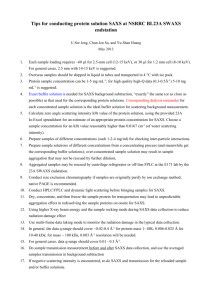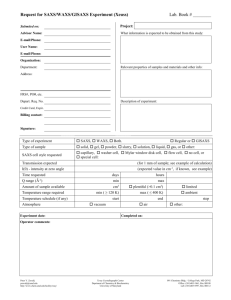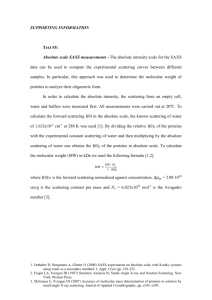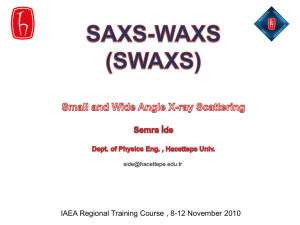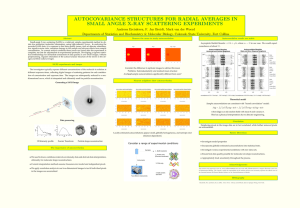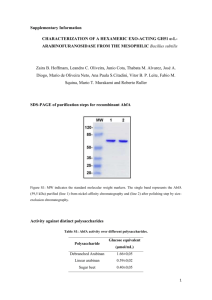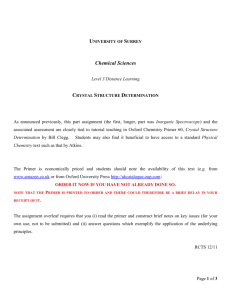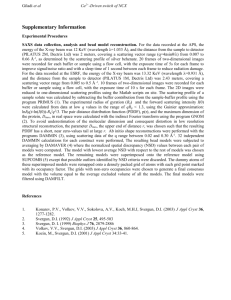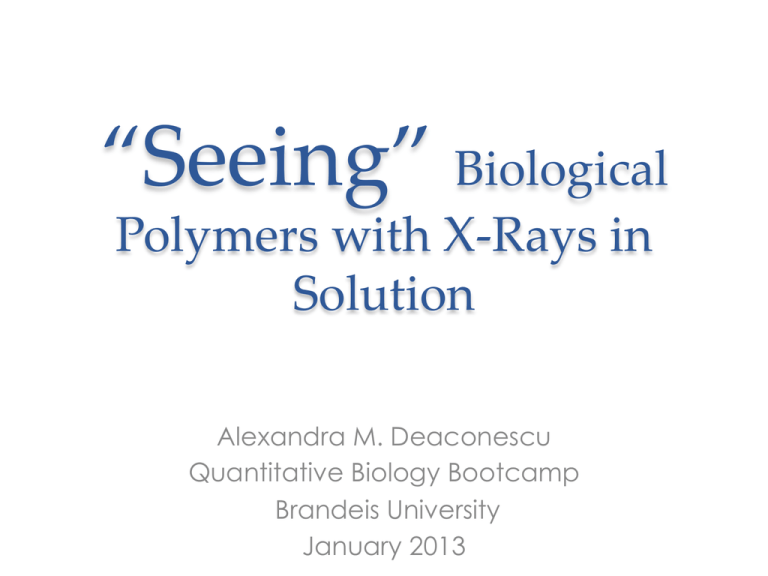
“Seeing” Biological Polymers with X-­‐‑Rays in Solution
Alexandra M. Deaconescu
Quantitative Biology Bootcamp
Brandeis University
January 2013
How can we “see” biological polymers?
(ATOMIC or NEAR-ATOMIC) STRUCTURE
DETERMINATION TECHNIQUES
•
•
•
•
X-ray, neutron and electron crystallography
Nuclear magnetic resonance (NMR)
Cryo-electron microscopy (EM)
Small-angle X-ray scattering (SAXS)
Why Is It Important to See
Biological Assemblies and Polymers?
Structure Dictates Function
hQp://www.brianjford.com/wav-­‐‑spf.htm
Antony van Leeuwenhoek, 1678
1674 The Infusoria -­‐‑ (Protist class in modern Zoology)
1676 The Bacteria (Genus Selenomonas -­‐‑ crescent shaped bacteria from human mouth)
1677 The Spermatozoa 1682 The banded paQern of muscular fibers Structure Dictates Function: Bacterial
Light Microscopy
Flagella
Electron Microscopy
hQp://www.bmb.leeds.ac.uk/illingworth/6form/
index.htm
Electron Microscopy
X-­‐‑ray Crystallography
Keiichi Namba Lab, Osaka University
Electron Microscopy
Thomas et al., Mol Bio Cell (1999)
The Electromagnetic Spectrum
Synchrotron radiation
Soft X-Rays
(10 nm to 0.1n m)
Easily absorbed in air
hQp://aworldwideawake.com/2012/01/
Hard X-Rays
(<0.1nm)
Penetrant
• X-ray crystallography
• SAXS
(wavelength ~1Å)
Electrons, Neutrons or X-rays?
d ~ Wavelength
• Electrons (diffraction, EM) Coulombic potential maps ( λ=pm at 200kV)
• X-rays wavelengths (diffraction and SAXS): typically 0.8-1.5Å
- interact with electron cloud electron density maps
- can take advantage of anomalous scattering
- many synchroton beamlines
- (relatively) easy sample preparation
• Neutrons (diffraction and SANS) -> neutron density maps (λ=4-20Å @NIST
-interact with atomic nuclei
-generate fewer free radicals (minimal radiation damage)
-very few beamlines (ESRF) and relatively weak and costly
-low signal to noise ratio
-more difficult sample preparation (deuteration)
What Can SAXS Do?
• Structure of metal alloys, synthetic polymers, emulsions, porous
materials, nanoparticles, biological macromolecules
• Works in solution under close-to-physiological conditions
• Measures shape and sizes
• Short response time
• Ideal for testing environmental parameters (pH, temperature,
salt concentration, presence of ligands and cofactors)
Why Choose SAXS (or not)?
• No need for crystals (X-ray crystallography)
• No need to derivatize with heavy-atoms for phases (X-ray
crystallography)
• No conformational selection (X-ray crystallography)
• In solution, under close-to-physiological conditions
• No grid-specimen interaction (EM)
• No staining artifacts (EM)
• Typically faster than X-ray crystallography, NMR or EM
Modest resolution (1-3nm)
How Big is Too Big (or Vice Versa)?
• No size limitation (unlike in EM, NMR or crystallography )
• Suitable for molecules from kDa to megadaltons (nm to µm)
P. furiosus protein
8.9 kDa
BID: 2HYPHP
SAM-­‐‑1 Riboswitch 30.1 kDa
BID: 2SAMRR
30S ribosomal subunit
S. Solfataricus
~1MDa
BID: SS30SX
SAXS Development
• 1930s-1950s polymers, porous
materials (Guinier; Fournet;
Kratky)
• 1960s and 1970s - biological
SAXS (hardware development)
• 1990s – beginning of ab initio
modeling for reconstruction of 3denvelopes
• Software development: ATSAS by
the group of Dmitri Svergun
(EMBL)
André Guinier (1911-­‐‑2000)
(www.iucr.org)
With J. Friedel
hQp://www.lps.u-­‐‑psud.fr/spip.php?article829&lang=en
• Most hardware to generate, prepare and detect X-rays is shared with
crystallography (dual purpose beamlines, e.g. Sibyls at ALS)
Tom Ellenberger, Bio 5325, wustl.edu
Scattering Vector q
ks
Innovation with Integrity
q
2
© Copyright Bruker Corporation. All rights reserved.
q
ki
64
4 sin /
d=2 /q
For isotropic systems (fluid
polycrystals):
no direction dependence of
radiation
Adapted from Petoukhov, M., EMBO lecture
Bruker AXS
Sample: 1-2 mg (>0.5mg/ml)
Thomson (elastic) scattering
Angles = 0-5 degrees
Q range: 0.001 to 0.45 Å-1 (d=µm to nm)
Variations on the setup
• Flow cell (capillary) instead of a simple sample chambers
minimize radiation damage
• Flow cell may be in-line with SEC
Fig.with
1. X-ray
interactions
for SAXS
crystallography
A. Both
SAXS and X-ray crystallography
Fig. 1. X-ray interactions
sample
for SAXSwith
and sample
crystallography
A.and
Both
SAXS and X-ray
crystallography
involve
placing
a
sample
(orange)
into
a
highly
collimated
X-ray
beam
(red)
and
involve placing a sample (orange) into a highly collimated X-ray beam (red) and measuring the scatteredmeasuring
X-rays. the scattered X-rays.
The
angle
of
any
scattered
position
with
the
direct
beam
is
2.
B.
Scattering
from
a
solution
The angle of any scattered position with the direct beam is 2. B. Scattering from a solution of yeast PCNA
with of yeast PCNA with
a
maximum
resolution
of
23.9
Å.
C.
Diffraction
from
a
nickel
superoxide
dismutase
crystal
a maximum resolution of 23.9 Å. C. Diffraction from a nickel superoxide dismutase crystal at 2.0 Å resolution. at 2.0 Å resolution.
equivalent
of of
thethe
highest
of is
theindicated
SAXS experiment
indicated
(red circle). The blue circle
The equivalent positionThe
of the
highest position
resolution
SAXSresolution
experiment
(red circle).is The
blue circle
-1
indicates
the
highest
resolution
-1 achievable (q=0.6 Å ) for SAXS data collection. Both images collected at beamline
indicates the highest resolution achievable (q=0.6 Å ) for SAXS data collection. Both images collected at beamline
(SIBYLS)
at the
Lawrence
Berkeley National
Laboratories.
Diffraction
courtesy David Barondeau,
12.3.1 (SIBYLS) at the12.3.1
Lawrence
Berkeley
National
Laboratories.
Diffraction
image courtesy
David image
Barondeau,
Department
of
Chemistry,
Texas
A&M
University.
Department of Chemistry, Texas A&M University.
• Molecules “frozen” in lattice
• Non-isotropic
• Convolution of the molecular
transform with the lattice
• Discrete maxima
The theoretical
underpinnings
for both of
understood
and have been the subject
• techniques
High are
SNR
The theoretical underpinnings
for both
of these techniques
arethese
well
understood
andwell
have
been the subject
of recent
reviews
Vachette
& Svergun,
and
excellent
(Blundell
& Johnson, 1976; Drenth,
of recent reviews (Koch,
Vachette
& (Koch,
Svergun,
2003) and
excellent2003)
books
(Blundell
& books
Johnson,
1976;
Drenth,
•
Crystal
needs
to
be rotated
1994;; Giacovazzo et al., 1992). Our goal here is therefore to not to exhaustively address each technique, but 1994;; Giacovazzo et al., 1992). Our goal here is therefore to not to exhaustively address each technique, but to introduce and draw parallels between them. We expect that crystallographers will benefit primarily from the • Many observations/parameter
to introduce and draw parallels between them. We expect that crystallographers will benefit primarily from the introduction to SAXS and that SAXS specialists will most from introduction to macromolecular introduction to SAXS and that SAXS specialists (2007)
will benefit most from benefit the introduction to the macromolecular to
be
refined
(at
least at high
Putnam
et
al.,
Q
Rev.
Biophysics
crystallography.
We
highlight
areas
of
overlap
with
the
expectation
that
some
crystallography. We highlight areas of overlap with the expectation that some appreciation of bothappreciation
techniques of both techniques
will
be important
for X-ray
using techniques
these pairedfor
X-ray
techniques
for theofgrowing
number of
multi-resolution structure
resolution)
will be important for
using
these paired
the growing
number
multi-resolution
structure
•
•
•
•
•
Tumbling molecules
Radially symmetric (isotropic)
Low SNR
Few observations/parameter
(underdetermined)
determination problems.
Putnam, Hammel, Hura, Tainer: Submitted to Quarterly Reviews in Biophysics 9/17/07
Low angle
beamstop
Putnam, Hammel, Hura, Tainer: Submitted to Quarterly Reviews in Biophysics 9/17/07
High angle
Anatomy of a Scattering Intensity Curve
• radially-average intensity distribution to obtain 1-d curve, I(q)
• I is a function of momentum transfer q=4πsinΘ/λ (Å-1) or directional
momentum change that photons undergo
• Normalization (against exposure time, transmitted sample intensity)
qmax=2π/d
2.5#
After background subtraction
I~ scattering of single particle
averaged over all orientations
2#
logI%
1.5#
High resolution
(large scattering
angle)
1#
0.5#
0#
!0.5#
!1#
0.00#
0.05#
0.10#
0.15#
0.20#
4pi*sin(theta)/lambda%(Å71)%
0.25#
1/d reciprocal resolution
(nominal)
0.30#
What is Being Measured?
1. Scattering from sample of interest (protein)
2. Background scattering (buffer, water, quartz cell etc.)
3. Electronic noise, stray X-rays (not passing through
samples)
I(q) ~ (ρp-ρs)2P(q)S(q)
Contrast
Form factor (SHAPE and SIZE)
Factor
ρ=electron density
Structure factor
(1 for ideal, dilute
solutions)
Small-Angle
Scattering
is
a
Contrast
129
ournal of Structural Biology 172 (2010) 128–141
Technique
Mertens & Svergun (2010)
J. Struct. Biol
•
The contribution of bulk solvent to scattering is explicitly subtracted
veraged data.
out(A) Standard scheme of a SAS experiment. (B) X-ray scattering patterns from a
solvent scattering and the difference curve (containing the contribution from the protein alone,
• Background subtraction is VERY important (measure “sample” and
“matching buffer” series)
SAXS is a Contrast Technique
I ~ρprotein - ρsolvent
electron
density of protein
•
•
electron
density of solvent
Proteins are made up of light atoms (low Z), which do not scatter very
well (as opposed to DNA/RNA, which gives better contrast)
typically 5% above background
ρprotein= 0.44 e-/Å3
ρwater= 0.33 e-/Å3
• use relatively large protein
concentrations (1-10mg/ml)
Scattering from an Ideal Solution
• No interaction between particles (no interparticle interference, e.g.
aggregation or repulsion)
• Only one species (monodisperse)
• Particles are free to move (independent scatters)
• I(q) = (ρ1-ρs)2P(q)S(q)
To a limited extent, interparticle interference can be dealt with.
But, for analysis, solution has to be monodisperse.
Best to use orthogonal methods (e.g. SEC, AU,
maybe native PAGE, mass
spectrometry, or best MALS-SEC) to ensure
monodispersity
What Kind of Parameters Can We Extract from
Scattering Curves?
Data Processing
2D image 1D curve
Background substraction
Size (Guinier plot)
Data Analysis
Conformation (Kratky plot)
Model-independent
Pair Distribution Function
Low resolution molecular envelope
Model-dependent
A. Model independent analysis (directly from
the scattering curve)
Size
Sizes
Log I(s)
s, Å-1
Al Kikhney, BIOSAXS
hQp://www.embl-­‐‑hamburg.de/biosaxs/courses/embo2012/
I. Forward Scattering I0 and Molecular
Masses
I0 ~ (electrons in the particle)2
I0 ~ particle concentration
• If the particle concentration is known, measurements can be
calibrated with a known monodisperse protein (e.g. glucose
isomerase NOT BSA), yielding the molecular mass of the solute
of interest.
• An ensemble measurement (monodispersity again!)
- Calculated by extrapolation (coincident with the direct beam)
hydrated/solvated particle. Hence the terminology, ‘hydrodynamic’ radius.
A comparison of the hydrodynamic radius to other types of radii can be shown using
lysozyme as an example (see Figure 2). From the crystallographic structure, lysozyme
can be described as a 26 x 45 Å ellipsoid with an axial ratio of 1.73. The molecular
weight of the protein is 14.7 kDa, with a partial specific volume or inverse density of
0.73 mL/g. The radius of gyration (Rg) is defined by the expression given below, where
mi is the mass of the ith atom in the particle and ri is the distance from the center of mass
the ith particle. RM is the equivalent radius of a sphere with the same mass and particle
Rto
distance of an object’s part from the
g (root-mean-square
specific
volume as lysozyme, and RR is the radius established by rotating the protein
about the geometric
center.
gravity),
a function
of a particle’s mass distribution (size)
II. Radii of Gyration – the Guinier Plot
•
2
∑m r
∑m
Guinier equation
R 2g =
center of
Data range
i i
i
Scattering intensity can be expanded in powers of q2:
I (q)
I ( 0) 1
Rg2 q 2
3
kq 4
Guinier 1939
Guinier and Fournet 1955
When q 0,
2 2
R
q
g
hQp://www.malverninstruments.com/
)
I (q ) I (0) exp(
3
qRg<1.3 for globular;
qmin
• qRgR
can
calculated
fromradius
the(Rslope
the
Guinier Plot (lnI
Comparison
of hydrodynamic
radii
for lysozyme.
H) to otherof
<0.8
for2:be
elongated
gFigure
2), but the limits of the Guinier regime is dependent on
versus
q
It is instructive to note here, that RM is the hypothetical radius for a hard sphere with the
I(0):
forward
scattering
mass and
density
as lysozyme.
might
expect then, to
see a closer correlation
of for
thesame
type
of
shape
(largerOnefor
globular
objects,
smaller
RM withof
RHgyration
. Remember however, that RH is the hydro-dynamic radius, which includes
Rg:elongated
radius
shapes, qRg<0.8)
both solvent (hydro) and shape (dynamic)
effects.
Shapes
Shape
lg I(s), relative
0
Long rod
-1
-2
-3
Solid sphere
-4
-5
-6
0.0
0.1
0.2
0.3
0.4
0.5
s, s
nm-1
Hollow sphere
Dumbbell
Al Kikhney, BIOSAXS
hQp://www.embl-­‐‑hamburg.de/biosaxs/courses/embo2012/
Flat disc
Persistence Length-Folded versus
Unfolded
• Kratky Plot: I(s)s2 versus s; generally bell-shaped when folded
Mertens & Svergun (2010) J. Struct. Biol.
PairFunction
distance distribution fu
The Pair Distribution
Atom Pair Distance
Histogram
r
sin qr
2
p(r )
2
2
0
n
x
q 2 I (q)
qr
dq
p(
2dr
Data range
r
Fourier transform
Dmax
sin qr
r (r )
dr
Reciprocal (Fourier) space
qr
2
I (q )
4
Real space
I (0)
D max
0
4
The PDDF of a molecule is the (net-charges and dista
weighted atom-pair distance histogram.
Can be used to determine D , I(0), shape, etc.
P(r) versus
a Patterson
Function
Pair Distribution
Function
Tom Ellenberger, Bio 5325, wustl.edu
The Pair Distribution Function
function Distance)
(Similar top(r)
a “Patterson”
Distance distribution function
Svergun and Koch (2003)
@Dmax=0
P(r)
Oligomerization
Changes
P(r)
: inverse Fourier transform
of
scattering function : Probability of
p(r)
finding a vector of length r between
scattering centers within the
scattering particle.
Dmax and
Dmax
r
4
4
4
4
3
3
3
3
2
2
2
2
1
1
1
1
0
0
1
r (Å)
0
0 2
0
0
1
0 3
0
0
02
04
0
2 3 0 05
0
0 00
44 00
2
0
Dmax
Shape : Modeled as a uniform density distribution that best
fits the scattering data.
35
Managed by UT-Battelle
for the U.S. Department of Energy
Presentation_name
neutrons.ornl.gov/.../Small-­‐‑Angle-­‐‑ScaQering_SAS_V-­‐‑
Urban-­‐‑ORNL-­‐‑...
5
Dimer 1, (B/2 = 755 Å2)
RG = 26.08 Å Dmax = 80 Å
Dimer 3, (B/2 = 406 Å2
RG = 28.3 Å Dmax = 90
Differentiating between Crystal Packing
y relevant symmetry operators can also be part of the underlying symmetry of the crystal structure so
s of the asymmetric unit cannot be used as a guide for the biological assembly. Thus, crystallographers
her which macromolecular contacts mediate multimerization in solution and which are only crystal
and Oligomerization in Solution
many cases identifying the biological multimer can be a difficult problem. Systematic investigation Dimer 2, (B/2 = 923 Å2)
A
RG = 34.04 Å Dmax = 120 Å
B
P(r), arbitrary units
Dimer 3, (B/2 = 406 Å2)
RG = 28.3 Å Dmax = 90 Å
6
5
4
3
2
1
0
Dimer 2, (B/2 = 923 Å2)
RG = 34.04 Å Dmax = 120 Å
20
Dimer 1
Dimer 3
Dimer 4
Dimer 2
40
60
80
100
120
r (Å)
2
Dimer 4, (B/2 =Fig.
255
) could have readily distinguished between alternative dimer structures of the C-te
10. Å
SAXS
of MutL
observed
in the crystal structure (PDB id 1x9z; (Guarne et al., 2004)). A. Each of t
RG = 30.4 Å Dmax
= 100
Å
6
different dimers has remarkably different overall shapes, giving rise to measurable differences in
scattering and parameters such as RG and Dmax. Dimer 1, with a buried surface area of the mono
755 Å2, is the asymmetric unit of the crystal, whereas dimer 2, with a buried surface area of 92
the solution dimer assembly (Kosinski et al., 2005). B. Theoretical P(r) functions calculated fo
1 (black) and dimer 2 (red) are readily distinguished. Dimer 1 has a characteristic globular P(r
bell-shaped, whereas dimer 2 has a characteristic extended P(r) with an early peak and a long t
4
of atomic resolution structures has shown that authentic interfaces tend to be large and in
C-­‐‑terminal domain of DNA repair protein MutL
5
Putnam et al., Q Rev. Biophysics (2007)
ry units
B
0
Putnam, Hammel, Hura, Tainer: Submitted to Quarterly Reviews in Biophys
Dimer 1, (B/2 = 755 Å2)
RG = 26.08 Å Dmax = 80 Å
Dimer 4, (B/2 = 255 Å2
RG = 30.4 Å Dmax = 100
What kind of parameters can we extract from
scattering curves?
A. Model-dependent analysis (directly from the
scattering curve)
B. Model-dependent (3D-reconstruction)
3D shape reconstructions from SAXS data: a general idea
3D Reconstructions by Ab Initio
Obtaining 3D shapes from 1D SAXS data is an ill-defined problem that can be solved by regularizing
the fitted models.
Simulations: How?
Imposing prior restraints on the fitted models such as non-negativity and compactness/connectivity
greatly
stability.
• 3Dincreases
searchsolution
model
- trial and error
fit against experimental data
Dmax
MC
SA
Model Space
Fitted Data
Low-resolution model
Dummy Atoms/Residues Assigned to Either Solvent or
Available Programs:
Model
Genetic Algorithm: DALAI_GA (1998)
Simulated Annealing (to find “global” minimum)
Simulated Annealing: DAMMIN (1999), GASBOR (1999)
Monte Carlo: saxs3d (1999)
NIH SAXS Workshop
Monte Carlo: LORES (2005)
hQps://ccrod.cancer.gov/confluence/download/.../
PartTwo.pdf
3D Reconstructions by Ab Initio
Simulations: How?
Constraints:
1. Packing and connectivity (3.8Å
between scattering centers)
2. Symmetry (if present according to
orthogonal method)
NIH SAXS Workshop
hQps://ccrod.cancer.gov/confluence/download/.../
PartTwo.pdf
Multiple Simulations Need to Be Computed
Reconstruction depends on initial conditions
>10 independent simulations per sample
Align models
Analyze for convergence (NSD = normalized spatial
discrepancy)
• Filter composite volume based on occupancy
• Find common features in your reconstructions
•
•
•
•
Solutions are Similar
but Not
1763
ical macromolecules
Identical
(b)
(c)
(
Z-­‐‑disc domains of Titin (largest known protein, 35000 amino acids) Svergun & Koch (2003)
(d)
So What Else Is It Good For?
Factor
Modeling
• Help identify buffer conditions likely to produce crystals (non-aggregated
•
Validate crystal structures
se inprotein)
biology
•
•
Locate domains and missing linkers (e.g. not visible in crystal structures)
Look at dynamics of domains (ensemble of models, EOM and MES)
cs (Svergun, Stuhrmann, Grossman …)
eres (Svergun, Doniach, Chacón, Heller …)
Building Larger Assemblies from Known
“Pieces”
Spastin hexamer
Model of a microtubule
seen in cross-­‐‑section
Roll-Mecak & Vale, Nature (2008)
SAXS Is Versatile, Fast and
Informative
TOMORROW: 1. Coupling transcrip7on and DNA repair with a dsDNA-­‐tracking motor 2. Post-­‐transla7onal modifica7on of tubulin by tubulin tyrosine ligase (TTL) Acknowledgements
The Grigorieff Laboratory
Dr. Niko Grigorieff
Dr. Jeff Gelles
Dr. Jané Kondev
Funding

